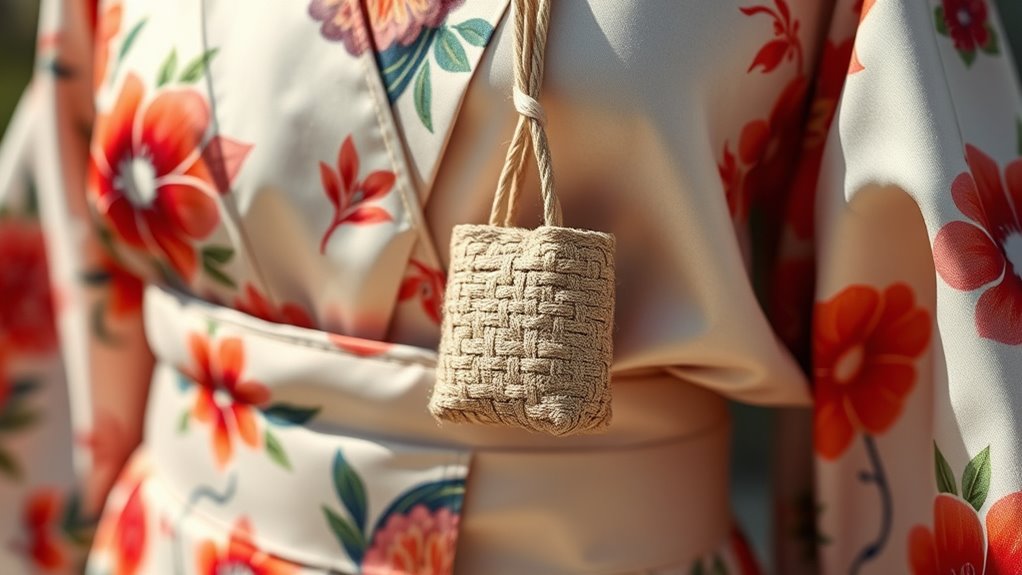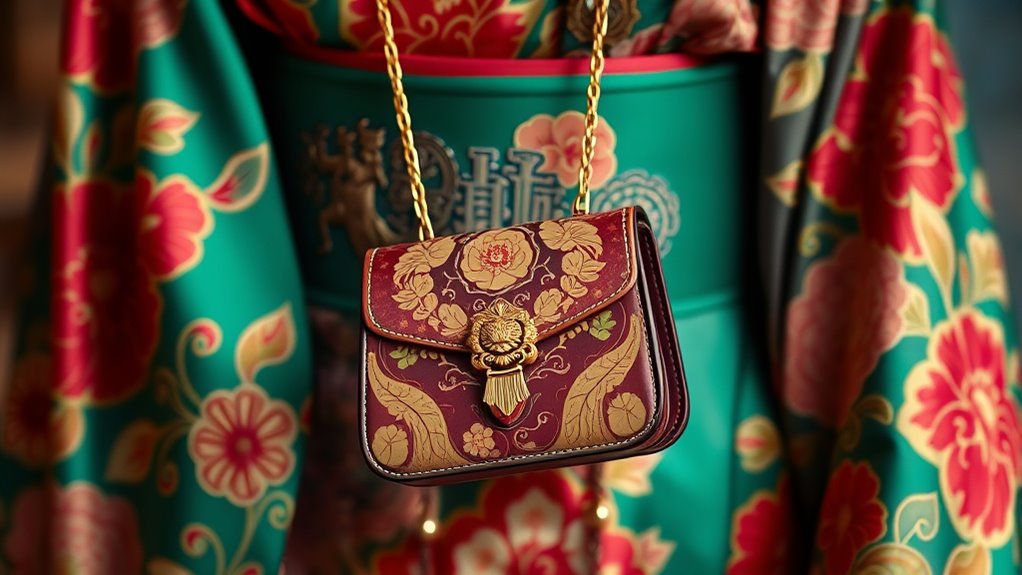In traditional Japanese dress, bags are more than just practical accessories—they’re elegant symbols of style and cultural tradition. You’re expected to choose bags that match the formality and harmony of the kimono, often made from luxurious materials like silk or lacquer. Proper handling and etiquette, such as holding bags with both hands or placing them carefully, show respect and decorum. To learn more about their significance and customs, continue exploring these timeless cultural details.
Key Takeaways
- Bags complement kimono style, color, and formality, serving both functional and aesthetic purposes.
- Crafted from luxurious materials like silk or lacquer, reflecting Japanese craftsmanship and tradition.
- Proper handling and etiquette, such as holding with both hands or placing on designated spots, demonstrate respect.
- Bag size and style vary according to the occasion, with formal events favoring small, elegant accessories.
- Beyond utility, bags express cultural appreciation and enhance the overall harmony and elegance of traditional dress.

Traditional Japanese dress often incorporates bags that serve both functional and aesthetic purposes, seamlessly blending practicality with cultural expression. When you wear a kimono, choosing the right bag isn’t just about carrying your essentials; it’s about respecting tradition and adding to the elegance of your overall look. Kimono accessories, including small pouches and handbags, are carefully selected to complement the garment’s style, color, and formality. These accessories are designed to be discreet yet stylish, often crafted from fine silk, brocade, or lacquered materials, reflecting the richness of Japanese craftsmanship. The goal is to maintain harmony with the kimono without overpowering it.
Kimono accessories blend tradition and elegance, crafted from luxurious materials to complement and honor Japanese craftsmanship.
Bag etiquette plays an important role in how you carry and handle these accessories. For formal occasions, you’re expected to hold your bag with both hands when standing or sitting, displaying a sense of decorum and respect. When walking, you might hang your bag from your wrist or carry it in your hand, ensuring it remains neat and unobtrusive. If you’re invited to a tea ceremony or formal gathering, it’s customary to set your bag down carefully on a designated spot, often a small table or shelf, to avoid cluttering the space or appearing inattentive. This shows your awareness of proper etiquette and your respect for the setting.
The size and style of your bag should match the formality of your kimono. For instance, a formal kimono such as a furisode or tomesode calls for a small, elegant clutch or kinchaku—a traditional drawstring pouch—made from luxurious fabrics that coordinate with your outfit. In casual settings, a slightly larger bag might be acceptable, but it should still adhere to the understated aesthetic typical of Japanese dress. When choosing kimono accessories, you’re encouraged to pay attention to details like color, texture, and the motif on the bag, ensuring it aligns with the season or occasion.
Ultimately, the role of bags in traditional Japanese dress extends beyond utility; they serve as an extension of your style and cultural appreciation. Understanding bag etiquette helps you navigate social expectations gracefully, while selecting the right kimono accessories enhances the overall harmony of your appearance. By respecting these customs, you honor the centuries-old traditions that continue to define Japanese elegance today.
Frequently Asked Questions
What Materials Are Commonly Used for Traditional Japanese Bags?
You’ll find that traditional Japanese bags are crafted from materials like silk, cotton, and hemp, showcasing exquisite fabric craftsmanship. Skilled artisans often use dyeing techniques like katazome and shibori to create intricate patterns and vibrant colors. These materials and techniques not only highlight Japan’s rich textile heritage but also guarantee the bags are durable, beautiful, and culturally significant, reflecting the artistry and tradition behind Japanese craftsmanship.
How Have Traditional Japanese Bags Evolved Over Centuries?
Over centuries, traditional Japanese bags have evolved through refined bag craftsmanship and changing design symbolism. You’ll notice a shift from simple, functional pouches to more intricate, decorative pieces that reflect cultural values and social status. Modern adaptations maintain traditional techniques while incorporating contemporary aesthetics, showcasing how craftsmanship and symbolism continue to influence their design. This evolution highlights Japan’s respect for tradition while embracing innovation.
Are There Specific Bags for Different Japanese Ceremonies?
You notice that specific bags are used for different Japanese ceremonies, reflecting seasonal bag designs and ceremonial bag significance. These bags serve to complement the occasion, honoring tradition and seasonality. Whether it’s a small, elegant pouch for a tea ceremony or a decorative bag for a wedding, each bag’s style, material, and design are carefully chosen to match the event’s importance and seasonal themes.
How Do Traditional Bags Influence Modern Japanese Fashion?
Traditional bags greatly influence modern Japanese fashion by inspiring accessory styling that blends cultural symbolism with contemporary trends. You’ll notice designers incorporating elements of traditional craftsmanship, like delicate embroidery or specific shapes, to add depth and meaning to their pieces. These bags serve as cultural symbols, connecting modern styles with historical roots, allowing you to express your identity while honoring Japan’s rich cultural heritage through thoughtful accessory choices.
What Symbolic Meanings Are Associated With Traditional Japanese Bags?
You’ll find that traditional Japanese bags carry rich cultural symbolism and artistic motifs. These bags often represent good luck, prosperity, or protection, reflecting deep cultural values. The intricate designs and patterns serve as artistic expressions, showcasing craftsmanship and regional identity. When you see these bags, you’re witnessing a blend of symbolism and artistry that connects you to Japan’s history and spiritual beliefs, making them much more than mere accessories.
Conclusion
Just like the sacred emptiness in a tea bowl, your bag completes your traditional attire, holding secrets and stories within. It’s more than just an accessory—it’s a silent partner in the dance of tradition and culture. As the kimono’s graceful folds symbolize harmony, your bag subtly echoes this balance. Embrace its role, and you’ll carry not just belongings, but the timeless essence of Japan’s heritage, forever woven into your own story.









